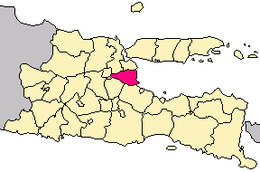Porong
|
Sidoarjo Regency (Kabupaten Sidoarjo) |
||
|---|---|---|
| Regency | ||
|
||
| Motto: Sidoarjo Bersih Hatinya | ||
|
Location of Sidoarjo in East Java |
||
| Coordinates: 7°27′S 112°42′E / 7.450°S 112.700°ECoordinates: 7°27′S 112°42′E / 7.450°S 112.700°E | ||
| Country |
|
|
| Province | East Java | |
| Area | ||
| • Total | 634.38 km2 (244.94 sq mi) | |
| Population (2014) | ||
| • Total | 1,996,034 | |
| • Density | 3,100/km2 (8,100/sq mi) | |
| Time zone | WIB (UTC+7) | |
| Website | www |
|
Sidoarjo Regency is a regency (kabupaten) of East Java, Indonesia.
Sidoarjo Regency is bordered by Surabaya city and Gresik Regency to the north, by Pasuruan Regency to the south, by Mojokerto Regency to the west and by the Madura Strait to the east. It has an area of 634.89 km², making it the smallest regency in East Java. As at the 2010 Census, Sidoarjo Regency had a population of 1,941,497; the latest official estimate (as at 2014) is 1,996,034. The regency is part of the urban region surrounding Surabaya, known as 'Gerbangkertosusila' area.
The Sidoarjo Regency was divided at 2010 into eighteen districts (kecamatan), tabulated below with their 2010 Census population.
As a satellite region and part of Greater Surabaya, Sidoarjo hosts number of manufacturing plants and factories. Among others are Maspion factories that produces household goods and ecco produce footware. Sidoarjo is also a fishing town, there are around 15,000 small and medium enterprises established in Sidoarjo, most of them are belongs to krupuk (traditional cracker) industry. Sidoarjo is also famous for its processed fisheries products, such as prawn cracker, fish cracker, shrimp paste and petis.
Since May 2006, more than 10,000 people in the Porong District have been displaced by the hot mud flowing from a natural gas well being drilled by Lapindo Brantas, an oil well company that is part of a conglomerate owned by Coordinating Minister for the People's Welfare Aburizal Bakrie. Gas and hot mud started spewing from the well on May 28, when the drill penetrated a layer of liquid sediment. Attempts to pump concrete down the well did not stop the flow. While some scientists have speculated that the earthquake that struck Yogyakarta on May 27, the day before the well erupted, may have cracked the ground, creating potential pathways for the mud to reach the surface, others have suggested that the drilling procedure was faulty by not using a casing. This is likely to be incorrect as technical papers on the subject showed that there were up to four sets of casing installed and cemented in the well. Some 50,000 cubic metres of hot mud were erupting every day as of August; in September, the amount increased to some 125,000 cubic metres daily. On September 26 barriers built to hold back the mud failed, resulting in the flooding of more villages. Gus Maksum, one of the thousands of Sidoarjo villagers displaced by the mud flow gives a detailed first-hand account of the first year of the disaster in his memoir Titanic Made By Lapindo. As of late September 2006 scientists are saying that the eruption may be a mud volcano forming, and may be impossible to stop.
...
Wikipedia


